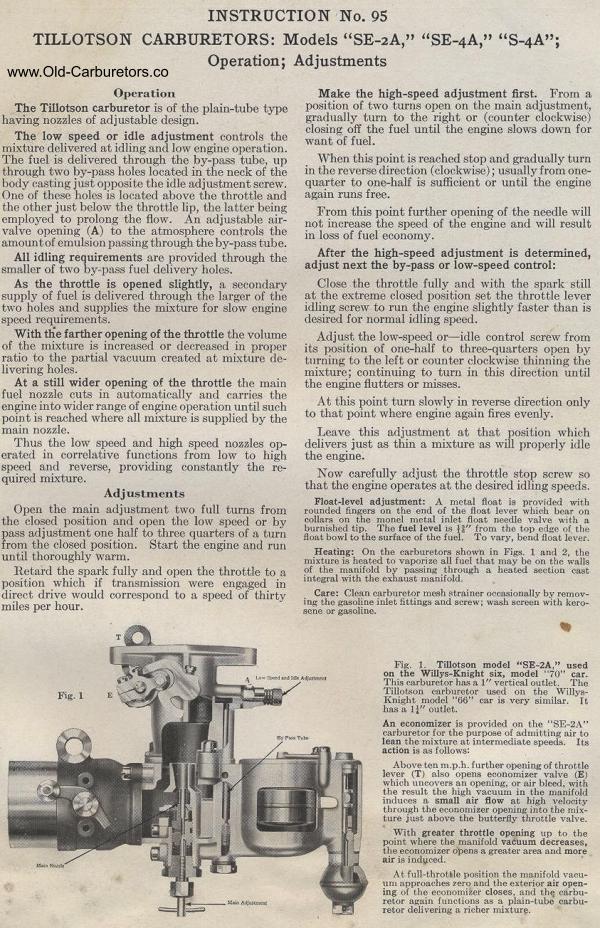TILLOTSON CARBURETORS
: Models "SE-2A," "SE-4A," "S-4A"
Operation; Adjustments
Operation
The Tillotson carburetor is of the plain-tube type having nozzles
of adjustable design.
The low speed or idle adjustment controls the mixture delivered
at idling and low engine operation. The fuel is delivered through
the by-pass tube, up through two by-pass holes located in the neck
of the body casting just opposite the idle adjustment screw. One
of these holes is located above the throttle and the other just
below the throttle lip, the latter being employed to prolong the
flow. An adjustable air-valve opening (A) to the atmosphere controls
the amount of emulsion passing through the by-pass tube.
All idling requirements are provided through the smaller of two
by-pass fuel delivery holes.
As the throttle is opened slightly, a secondary supply of fuel
is delivered through the larger of the two holes and supplies the
mixture for slow engine speed requirements.
With tile farther opening of the throttle the volume of the mixture
is increased or decreased in proper ratio to the partial vacuum
created at mixture delivering holes.
At a still wider opening of the throttle the main fuel nozzle cuts
in automatically and carries the engine into wider range of engine
operation until such point is reached where all mixture is supplied
by the main nozzle.
Thus the low speed and high speed nozzles operated in correlative
functions from low to high speed and reverse, providing constantly
the required mixture.
Adjustments
Open the main adjustment two full turns from the closed position
and open the low speed or by pass adjustment one half to three
quarters of a turn from the closed position. Start the engine and
run until thoroughly Warm.
Retard the spark fully and open the throttle to a position which
if transmission were engaged in direct drive would correspond to
a speed of thirty miles per hour.
Make the high-speed adjustment first. From a position of two turns
open on the main adjustment, gradually turn to the right or (counter
clockwise) closing off the fuel until the engine slows down for
want of fuel.
When this point is reached stop and gradually turn in the reverse
direction (clockwise) ; usually from one-quarter to one-half is
sufficient or until the engine again runs free.
From this point further opening of the needle will not increase
the speed of the engine and will result in loss of fuel economy.
After the high-speed adjustment is determined, adjust next the
by-pass or low-speed control:
Close the throttle fully and with the spark still at the extreme
closed position set the throttle lever idling screw to run the
engine slightly faster than is desired for normal idling speed.
Adjust the low-speed or — idle control screw from its position
of one-half to three-quarters open by turning to the left or counter
clockwise thinning the mixture; continuing to turn in this direction
until the engine flutters or misses.
At this point turn slowly in reverse direction only to that point
where engine again fires evenly.
Leave this adjustment at that position which delivers just as thin
a mixture as will properly idle the engine.
Now carefully adjust the throttle stop screw so that the engine
operates at the desired idling speeds.
Float-level adjustment: A metal float is provided with rounded
fingers on the end of the float lever which bear on collars on
the monel metal inlet float needle valve with a burnished tip.
The fuel level is la" from the top edge of the float bowl
to the surface of the fuel. To vary, bend float lever.
Heating: On the carburetors shown in Figs. 1 and 2, the mixture
is heated to vaporize all fuel that may be on the walls of the
manifold by passing through a heated section cast integral with
the exhaust manifold.
Care: Clean carburetor mesh strainer occasionally by removing the
gasoline inlet fittings and screw; wash screen with kerosene or
gasoline.
10
Fig. 1. Tillotson model "SE-2A," used on the Willys -
Knight six, model "70" car. This carburetor has a 1" vertical
outlet. The Tillotson carburetor used on the Willys
Knight model "66" car is very similar. It has a 1;" outlet.
An economizer is provided on the "SE-2A" carburetor for
the purpose of admitting air to lean the mixture at intermediate
speeds. Its action is as follows:
Above ten m.p.h. further opening of throttle lever (T) also opens
economizer valve (E) which uncovers an opening, or air bleed, with
the result the high vacuum in the manifold induces a small air
flow at high velocity through the economizer opening into the mixture
just above the butterfly throttle valve.
With greater throttle opening up to the point where the manifold
vacuum decreases, the economizer opens a greater area and more
air is induced.
At full-throttle position the manifold vacuum approaches zero and
the exterior air opening of the economizer closes, and the carburetor
again functions as a plain-tube carburetor delivering a richer
mixture.
Ball & Ball Carburetors 1927
Supplement Home More Tillotson
Carburetors

Tillotson Carburetors |